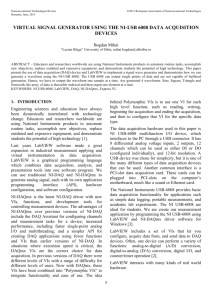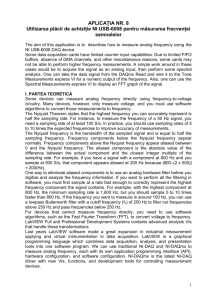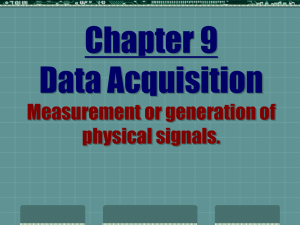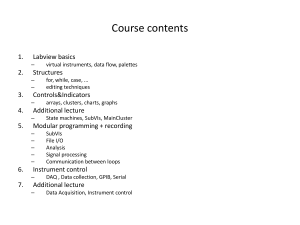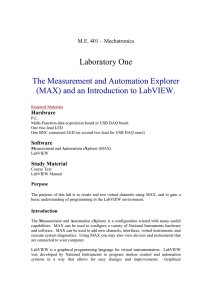Virtual Signal Generator with NI-USB 6008 & LabVIEW
advertisement
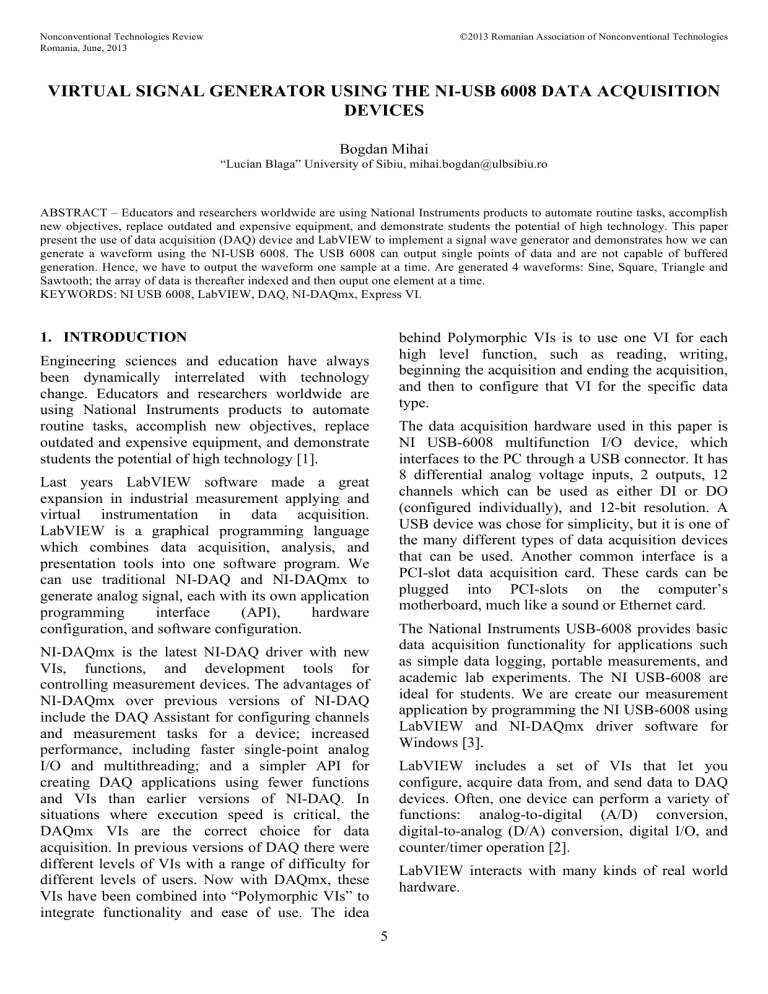
Nonconventional Technologies Review Romania, June, 2013 2013 Romanian Association of Nonconventional Technologies VIRTUAL SIGNAL GENERATOR USING THE NI-USB 6008 DATA ACQUISITION DEVICES Bogdan Mihai “Lucian Blaga” University of Sibiu, mihai.bogdan@ulbsibiu.ro ABSTRACT – Educators and researchers worldwide are using National Instruments products to automate routine tasks, accomplish new objectives, replace outdated and expensive equipment, and demonstrate students the potential of high technology. This paper present the use of data acquisition (DAQ) device and LabVIEW to implement a signal wave generator and demonstrates how we can generate a waveform using the NI-USB 6008. The USB 6008 can output single points of data and are not capable of buffered generation. Hence, we have to output the waveform one sample at a time. Are generated 4 waveforms: Sine, Square, Triangle and Sawtooth; the array of data is thereafter indexed and then ouput one element at a time. KEYWORDS: NI USB 6008, LabVIEW, DAQ, NI-DAQmx, Express VI. 1. INTRODUCTION behind Polymorphic VIs is to use one VI for each high level function, such as reading, writing, beginning the acquisition and ending the acquisition, and then to configure that VI for the specific data type. Engineering sciences and education have always been dynamically interrelated with technology change. Educators and researchers worldwide are using National Instruments products to automate routine tasks, accomplish new objectives, replace outdated and expensive equipment, and demonstrate students the potential of high technology [1]. The data acquisition hardware used in this paper is NI USB-6008 multifunction I/O device, which interfaces to the PC through a USB connector. It has 8 differential analog voltage inputs, 2 outputs, 12 channels which can be used as either DI or DO (configured individually), and 12-bit resolution. A USB device was chose for simplicity, but it is one of the many different types of data acquisition devices that can be used. Another common interface is a PCI-slot data acquisition card. These cards can be plugged into PCI-slots on the computer’s motherboard, much like a sound or Ethernet card. Last years LabVIEW software made a great expansion in industrial measurement applying and virtual instrumentation in data acquisition. LabVIEW is a graphical programming language which combines data acquisition, analysis, and presentation tools into one software program. We can use traditional NI-DAQ and NI-DAQmx to generate analog signal, each with its own application programming interface (API), hardware configuration, and software configuration. The National Instruments USB-6008 provides basic data acquisition functionality for applications such as simple data logging, portable measurements, and academic lab experiments. The NI USB-6008 are ideal for students. We are create our measurement application by programming the NI USB-6008 using LabVIEW and NI-DAQmx driver software for Windows [3]. NI-DAQmx is the latest NI-DAQ driver with new VIs, functions, and development tools for controlling measurement devices. The advantages of NI-DAQmx over previous versions of NI-DAQ include the DAQ Assistant for configuring channels and measurement tasks for a device; increased performance, including faster single-point analog I/O and multithreading; and a simpler API for creating DAQ applications using fewer functions and VIs than earlier versions of NI-DAQ. In situations where execution speed is critical, the DAQmx VIs are the correct choice for data acquisition. In previous versions of DAQ there were different levels of VIs with a range of difficulty for different levels of users. Now with DAQmx, these VIs have been combined into “Polymorphic VIs” to integrate functionality and ease of use. The idea LabVIEW includes a set of VIs that let you configure, acquire data from, and send data to DAQ devices. Often, one device can perform a variety of functions: analog-to-digital (A/D) conversion, digital-to-analog (D/A) conversion, digital I/O, and counter/timer operation [2]. LabVIEW interacts with many kinds of real world hardware. 5 To see what devices are recognized by the computer, go to Start » Programs » National Instruments » Measurement & Automation and then select My System » Devices and Interfaces. Physical Channel: A physical channel is a terminal or pin at which an analog or digital signal is measured or generated. Virtual Channel: A virtual channel is a collection of property settings that can include a channel name, a physical channel, input terminal connections, the type of measurement or generation, and scaling information. Task: A task in NI-DAQmx is a collection of one or more virtual channels with timing, triggering, and other properties. 2.1 Virtual signal generator Front Panel The front panel window is the user interface for the VI. Figure 3 shows a front panel window of the VI. Figure 1. NI-DAQmx Data AcquisitionVIs Under NI-DAQmx Devices section we see all of the devices listed, including NI USB-6008. Figure 3. Virtual instrument Front Panel The front panel is made with: • • • • Figure 2. My System Configuration one control to select Physical Chanals; two controls to select the Maximum and the Minimum Value of the generated signal; two controls for changing the amplitude and frequency of the generated signal; one Enum Control (Select) with 4 positions, for selecting the type of signal: 2. REALIZATION OF VIRTUAL INSTRUMENT 0-Sine DAQmx is the LabVIEW driver that has significantly simplified the programming of data acquisition hardware in LabVIEW. The following are the definitions related to DAQmx [4]. 2-Triangle 1-Square 3-Sawtooth • • 6 one STOP button; one graphical indicator to display the generated signal. 2.2 Virtual signal generator Block Diagram NI-DAQmx is the next generation drivers for the data acquisition hardware from National Instruments. Figure 4. Virtual instrument Block Diagram It is easy to use and has many new features such as improved ease of use, faster development time, multithreaded measurements and increased accuracy of measurements. NI-DAQmx can be used to generate analog signals if the data acquisition hardware has the analog output capability. The DAQmx VIs can be found under Functions >> All Functions >> NI Measurements >> DAQmx Data Acquisition. Figure 5. DAQmx Create Virtual Channel The following are the steps for creating virtual signal generator, block diagram. 2. Create the waveform data for the analog signal generation. I have used Simulate Signal Express VI to create the waveform. I used 4 Simulate Signal Express VI inserted in a Case Structure, for selecting the 4 types of signals (Sine, Square, Triangle and Sawtooth). 1. Create a virtual channel and task using the NIDAQmx Create Virtual Channel VI. Select Analog output and than voltage. - Physical Channels specifies the names of the physical channels to use to create virtual channels. The DAQmx physical channel constant lists all physical channels on devices and modules installed in the system. You also can wire a string that contains a list or range of physical channels to this input. 3. Call the Start VI to start the acquisition. This VI transitions the task to the running state to begin the measurement or generation. - Maximum value specifies the maximum value you expect to generate. Figure 6. DAQmx Start Task - Minimum value specifies the minimum value you expect to generate. If I do not use this VI, a measurement task starts automatically when the DAQmx Read VI runs. The 7 autostart input of the DAQmx Write VI determines if a generation task starts automatically when the DAQmx Write VI runs. software is in flexibility concerning requirements that could be also modify during experiments realisation. This paper demonstrates how to perform continuous analog output tasks on the NI USB-6008 and also incorporates the theory of operation that is associated with software timed analog output. Continuous software timed analog output means that your analog channel will update only once for every iteration of the program's while loop. It is also important to remember that these devices allow an output voltage range of 0 to 5 Volts. This VI outputs a signal wave (sine, square, triangle, and sawtooth) with a DC offset of 2.5V 4. REFERENCES 1. BogdanM., PanuM., ViorelA., Teaching data acquisition on a virtual laboratory, the 4thBalkan Region Conference on Engineering Education, ISSN 1843-6730, 12-14 Iulie, Sibiu, 2007. 2. Bogdan, M., Measurement experiment, using NI USB-6008 data acquisition, Journal of Electrical and Electronics Engineering, Vol.2, Nr.1, 2009, ISSN 1844-6035, University of Oradea Publisher, 2009. 3. Bogdan, M., Sampling rate and aliasing on a virtual laboratory, Journal of Electrical and Electronics Engineering, Vol.2, Nr.2, 2009, ISSN 1844-6035, University of Oradea Publisher, 2009. 4. Bogdan, M., Virtual instrument, for frequency measurement and spectral analysis, Journal of Electrical and Electronics Engineering ISSN/ EISSN: 18446035 20672128 Year: 2011 Volume: 4 Issue: 1 Pages: 19-22. 5. National Instruments LabVIEW Graphical Programming Course, 2007. 6. A quick guide to NI USB-6008/6009 I/O device, available at: http: //techteach.no/ publications/ labview. 7. E. Luther, Electronics Experiments Using USB Data Acquisition, available at: http: //cnx.org/content/col10393/. 8. http://zone.ni.com/devzone/cda/epd/p/id/6405. 9. https://decibel.ni.com/content/docs/DOC-16843. Figure 7. Simulate Signal Express VI inserted in a Case Structure If you do not use the DAQmx Start Task VI and the DAQmx Stop Task VI when you use the DAQmx Read VI or the DAQmx Write VI multiple times, such as in a loop, the task starts and stops repeatedly. Starting and stopping a task repeatedly reduces the performance of the application. 4. Write the waveform data in a loop until the user hits the stop button or an error occurs. Figure 8. DAQmx Write This VI write data to one or more channels. 3. CONCLUSIONS Compared with classical way of experimental investigation, main advantage of using DAQ with virtual instrumentation interface by LabVIEW 8
